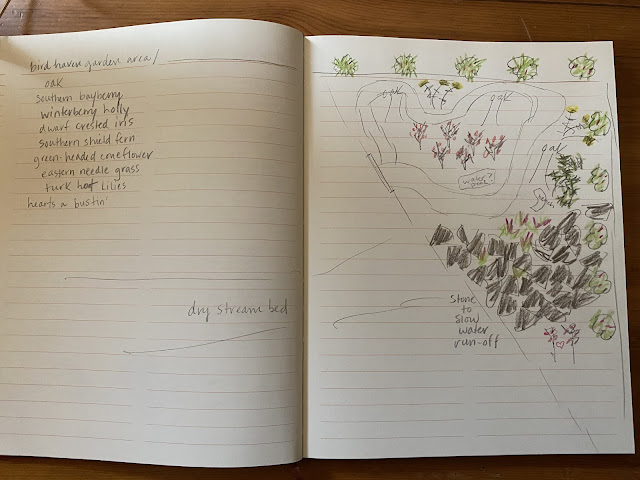On Friday evening we brought home the next batch of natives and yesterday planted those going into the bird haven garden space.
There was a great spot for the grouping of southern shield ferns, and they’re now in the ground. I chose these because the light they’ll get in the bird haven is perfect for their needs, and also because they get quite large and turn a bronze color in the fall, which I think will be quite stunning in that area.
I weeded a few things out of the space and we also put in the dwarf crested irises and the hearts a bustin’ shrubs. I have another thing going in that space today and then more coming Monday. My plan to create layers of height and foliage in that area is definitely coming to fruition this fall. I’m very excited to see how it grows into maturity.
Several of the southern bayberries that I planted inside the fence along the back of the bird haven space have died - they’re all in close proximity to large oaks and I’m not sure if that has something to do with it or if they just don’t like that area. I have come replacements coming Monday but am now wondering if another shrub or two would do better in this space.
For some reason I ordered two new species of native shrubs, two of each, and those will be here Monday as well, so I may switch out my plan a bit. I’ve learned that if a plant dies it is likely true that I didn’t place it in the right spot, or what I think fits in terms of light/soil isn’t quite the right match for it. There seems to be a spectrum where a thing grows and thrives to the point of spreading hugely, grows and thrives, but not so much that it takes over, and doesn’t thrive and gradually peters out.
It’s worth experimenting and also moving a plant to a new location before it dies. For these few bayberries (out of the 30+ we planted) I think I’ll try a different shrub. It’s very possible they didn’t like the wetness of their location during big rain events, and the new species I have coming very much do like wet feet, so hopefully I’ll solve the dilemma.
More on southern shield fern from NC State’s plant site:
- Thelypteris normalis is often confused with:
- Thelypteris noveboracensis

- Plants that fill a similar niche:
- Woodwardia areolata

- Thelypteris noveboracensis

- Phegopteris hexagonoptera

Thelypteris normalis
Previously known as:
- Thelypteris kunthi
- Phonetic Spelling
- theh-LIP-ter-iss KUN-thee-eye
- Description
Sun to partial shade; prefers average to humus-rich, moist soil but tolerates drought; short to long creeping rhizomes; spreads quickly to form colonies rather than clumps; easy to grow. This plant is seldom damaged by deer.
Long arching, triangular, bright sea green fronds; pinnate pinnatified blade; very hairy on upper and lower surface; sori have rounded indusia and are borne along the midvien of pinna lobes,







.jpg)







